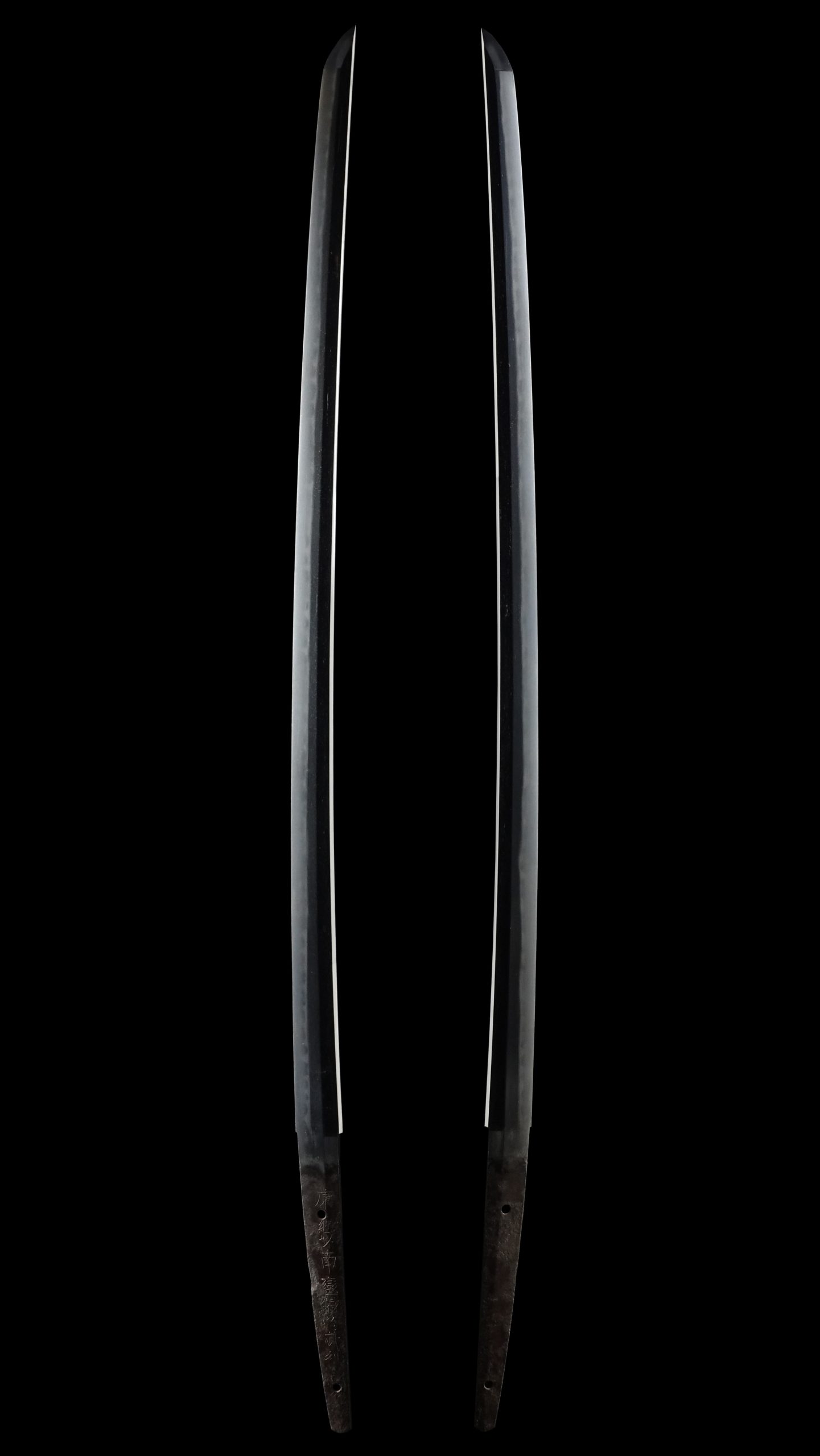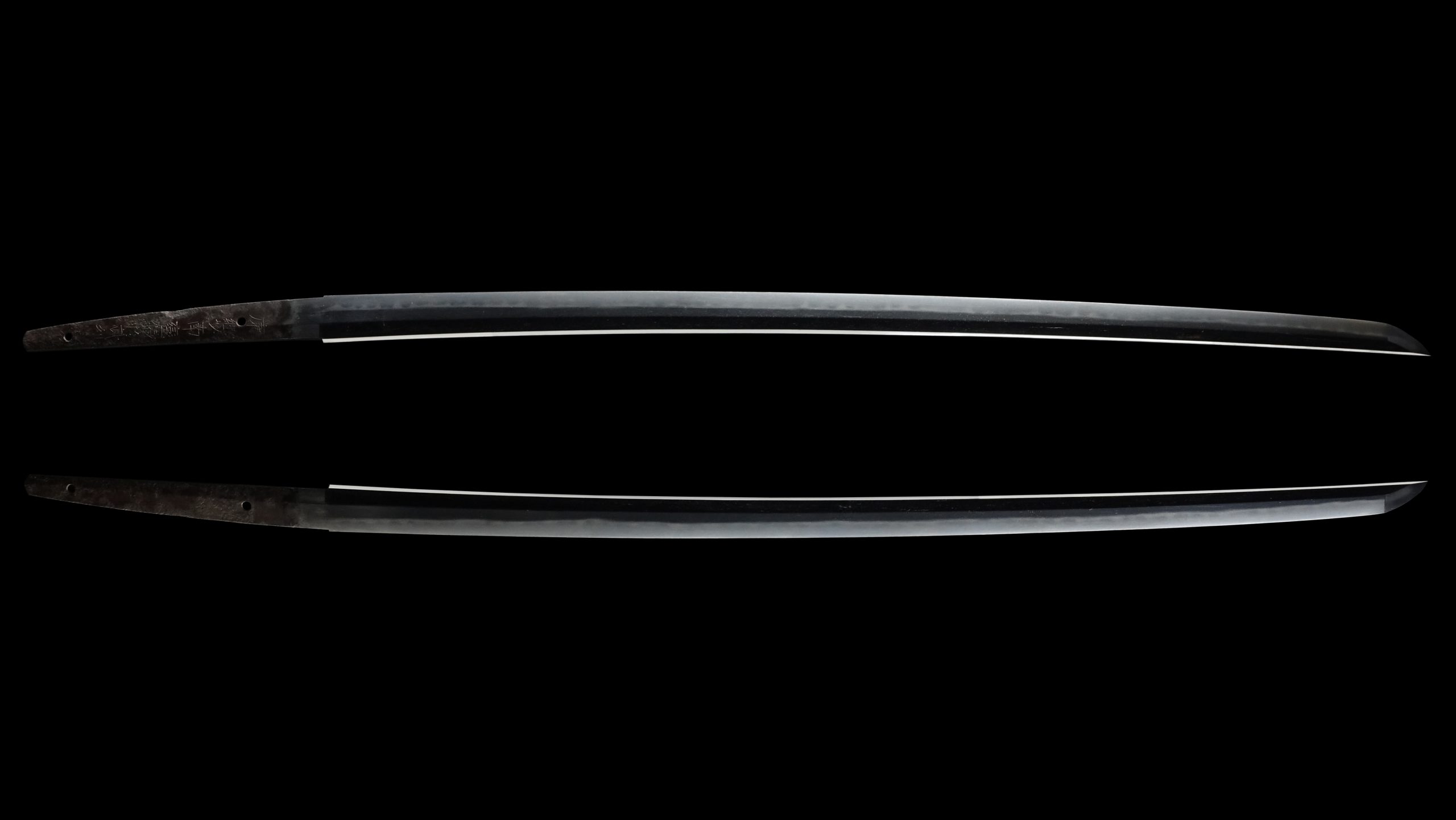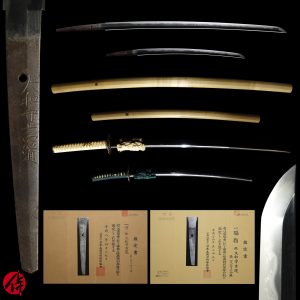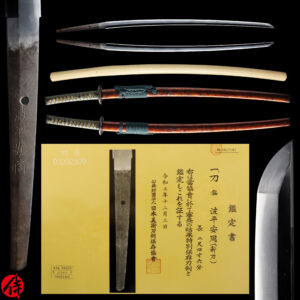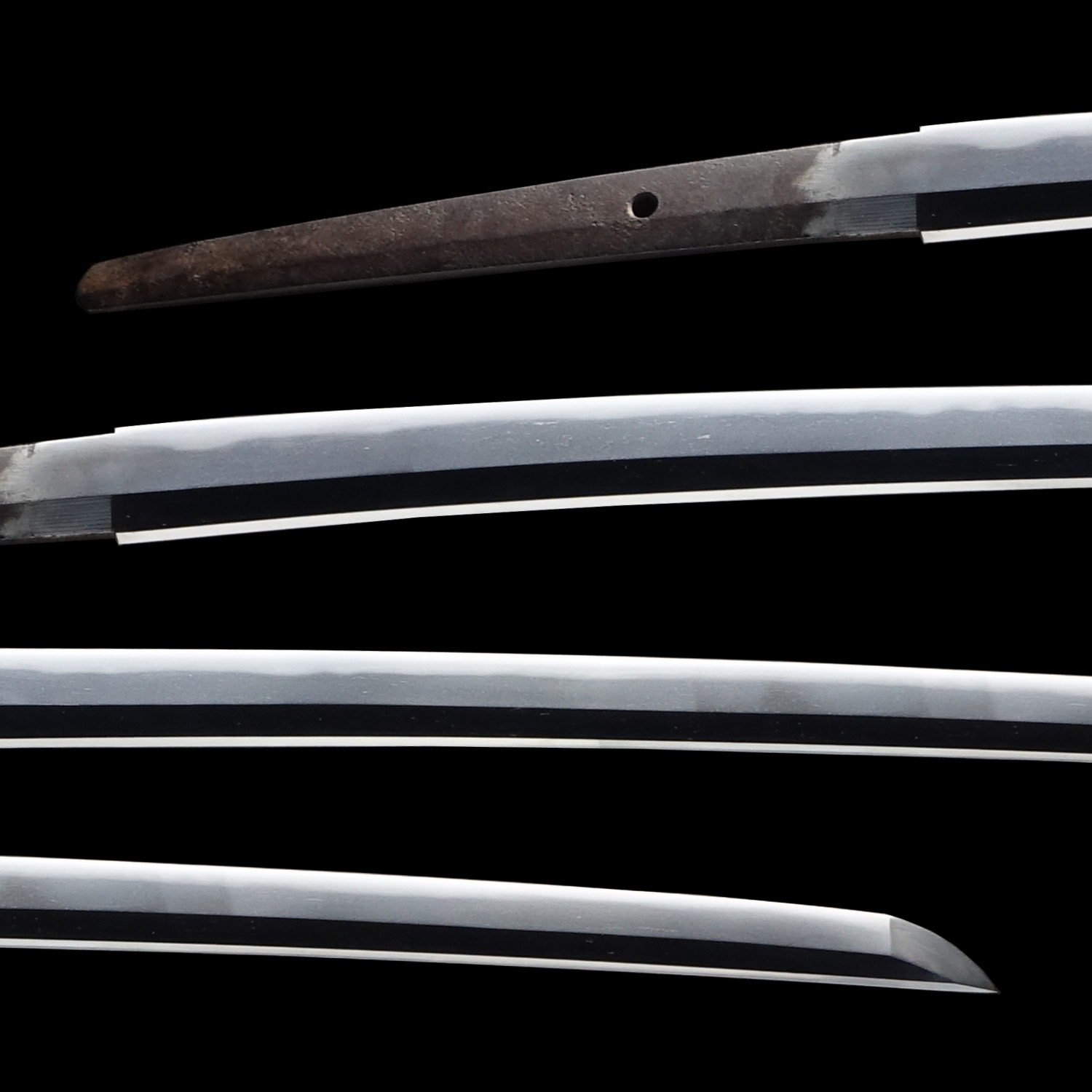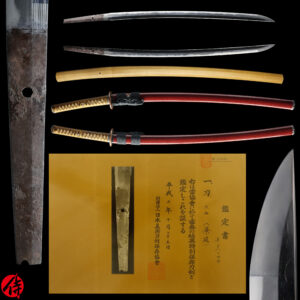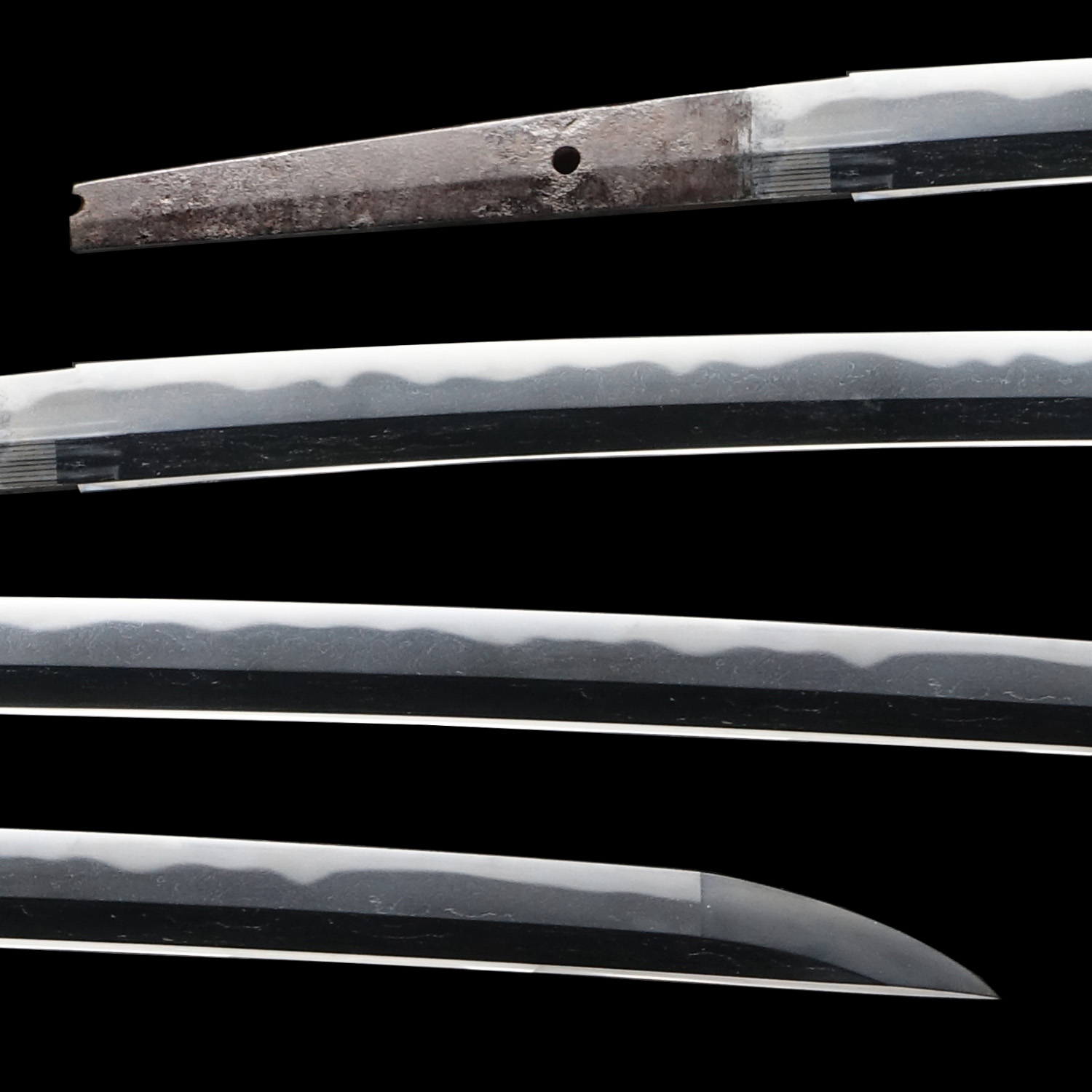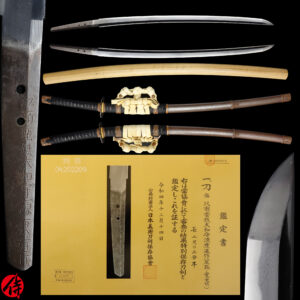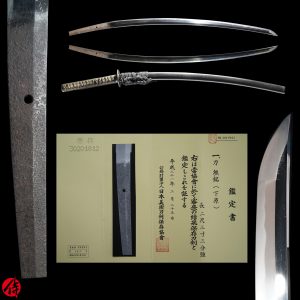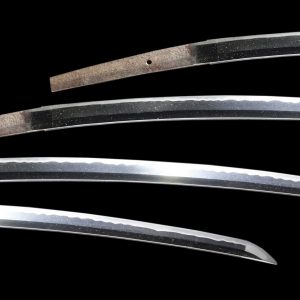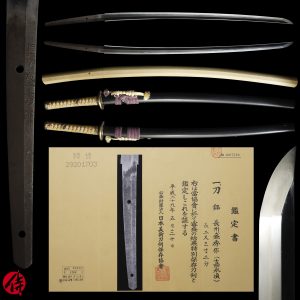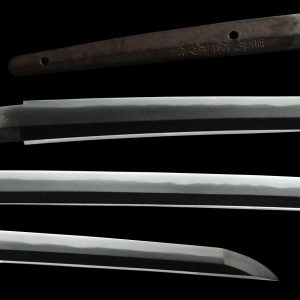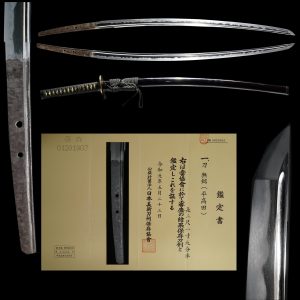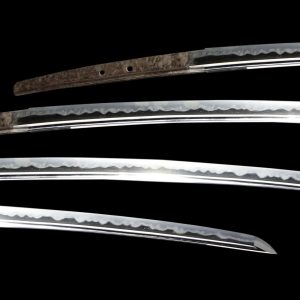Antique Japanese Sword Katana Signed by the third-gen Yasutsugu with Tokubetsu Hozon Certificate
【Description】
This blade was forged by the third-gen Edo Yasutsugu(江戸三代康継), according to the NBTHK’s appraisal. The signature also says that it was made of foreign carbon steel(Nanban Tetsu:南蛮鉄). He was active in sword-forging during the Kanbun-Enpo era(Early Edo period: 1661-1680). He was the first son of the second-gen Yasutsugu, who made swords until 1645 and died in 1646.
It is said that the first-gen Yasutsugu was born in Shimosaka town in Shiga prefecture at the end of the Muromachi period(Late 16 century ). He built his career there until the beginning of the Keicho era(1596). However, he moved to Echizen province due to the relocation of the lord he served. He eventually was noticed and supported by Matsudaira Hideyasu, the third son of Tokugawa Ieyasu, who was the founder of the Edo government. Hideysu who was the feudal lord of Echizen province during the early Edo period.
With the support of Hideyasu, the first-gen Yasutsugu was able to establish the Echizen Shimosaka school. And his school’s fame became nationwide.
By Hideyasu’s recommendation, the first-gen Yasutsugu became Okakaekaji for the Tokugawa shogun family, meaning that he exclusively forged swords for the Shogun family. Yasutsu was acknowledged by the first and second Tokugawa Shoguns, Tokugawa Ieyasu, and Tokugawa Hidetada.
The first-gen Yasutsugu received 康(YASU) from Tokugawa Ieyasu and changed his maker’s name. He was also allowed to inscribe the holly oak symbol(family crest of Tokugawa) on the tang.
The first-gen died in 1621, and the first son of him took over the school and became the second-gen Yasutsugu. As we explained earlier, the second-gen was deceased in 1646.The third-gen Edo Yastsugu was the first son of the second-gen Yasutsugu. His real name is Umanosuke(右馬助).
When the second-gen was deceased in the third year of Seiho(1646), Umanosuke was just 17 years old. Because of his young age, there was a dispute within the Echizen Yasutsugu school over who took over the school. The students of the second-gen Yasutsugu and Shogun’s arms office supported Umanosuke to be the third-gen Yasutsugu. However, the third son of the first-gen Yasutsugu insisted that he should be the one to take over his father’s school and property. The third son of Yasutsugu was Shirouemon(四郎右衛門) and younger brother of the second-gen Yasutsugu.
This dispute was eventually solved in such an interesting manner. Yasutusu school decided to have two third-gen Yasutsugu. While Umanosuke was officially appointed as the heir of Yasutsu school and became the third-gen Yasutsugu in Edo city, Shirouemon founded the Echizen Yasutsugu school. From this point, there were two branches of Yasutsugu school; Edo and Echizen.
Back then, Yasutsugu swordsmiths were requested to forge swords in Echizen and Edo back and forth every year, but this tradition ended after this dispute was settled.
Edo Yasutsugu school lasted for the 12th generation from the third-gen Edo Yasutsugu, and Echizen Yasutsugu lasted for the 9th generation. The work of the third-gen Yasutsugu resembles that of the first two generations, and his craftsmanship is said to be excellent among Japanese sword experts.
This blade cutting edge size is 75.1 cm(29.56 inches) and we assume it must have been owned by a highly skilled Samurai who could handle this long edge well. Since this blade was forged by a prestigious swordsmith, we believe it was owned by a high ranked Samuirai official in Edo.
This blade is appraised as Tokubetsu Hozon certificate issued by NBTHK. This authentication paper was only given to Japanese swords, especially worth preserving by Nihon Bijutsu Touken Hozon Kyokai(the Society for the Preservation of the Japan Art Sword).
【 Blade】
Cutting Edge Length(Nagasa): 75.1 cm(29.56 inches)
Curvature(Sori):0.9 cm(0.35 inches)

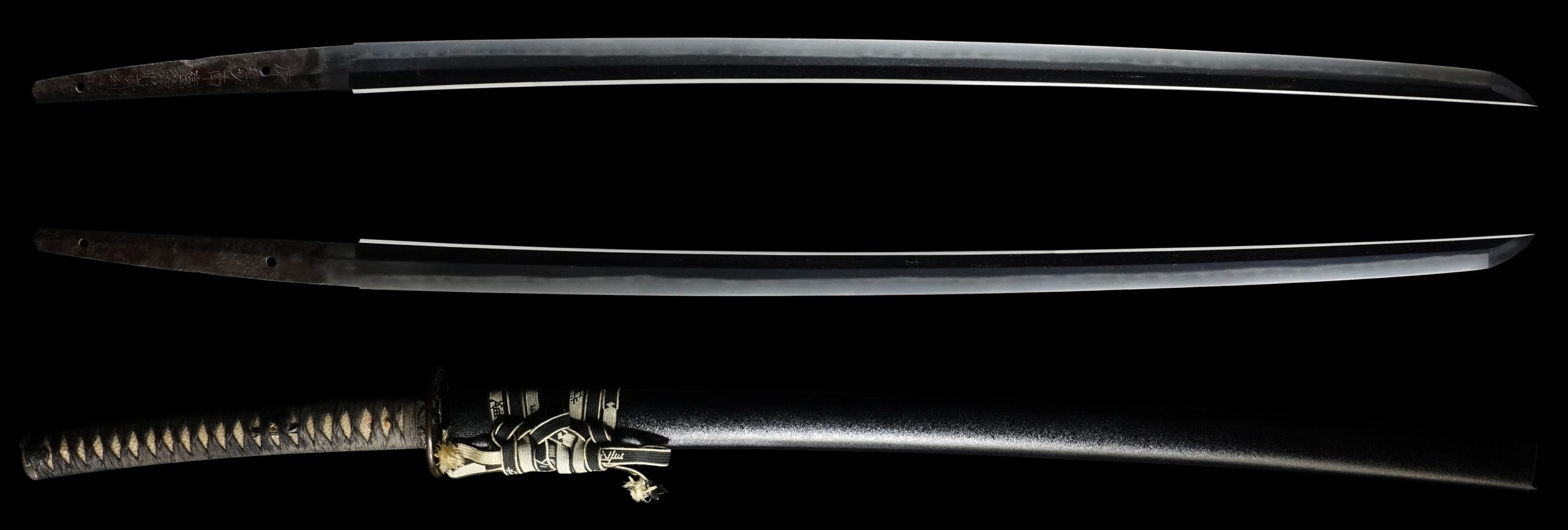
For more detailed measurement of the blade/sword mounting
Hamon:
The crystalline structure which forms along the cutting edge of a blade as a result of the hardening process
Jimon(Jihada):
visible steel surface pattern created by folding and hammering during forging process
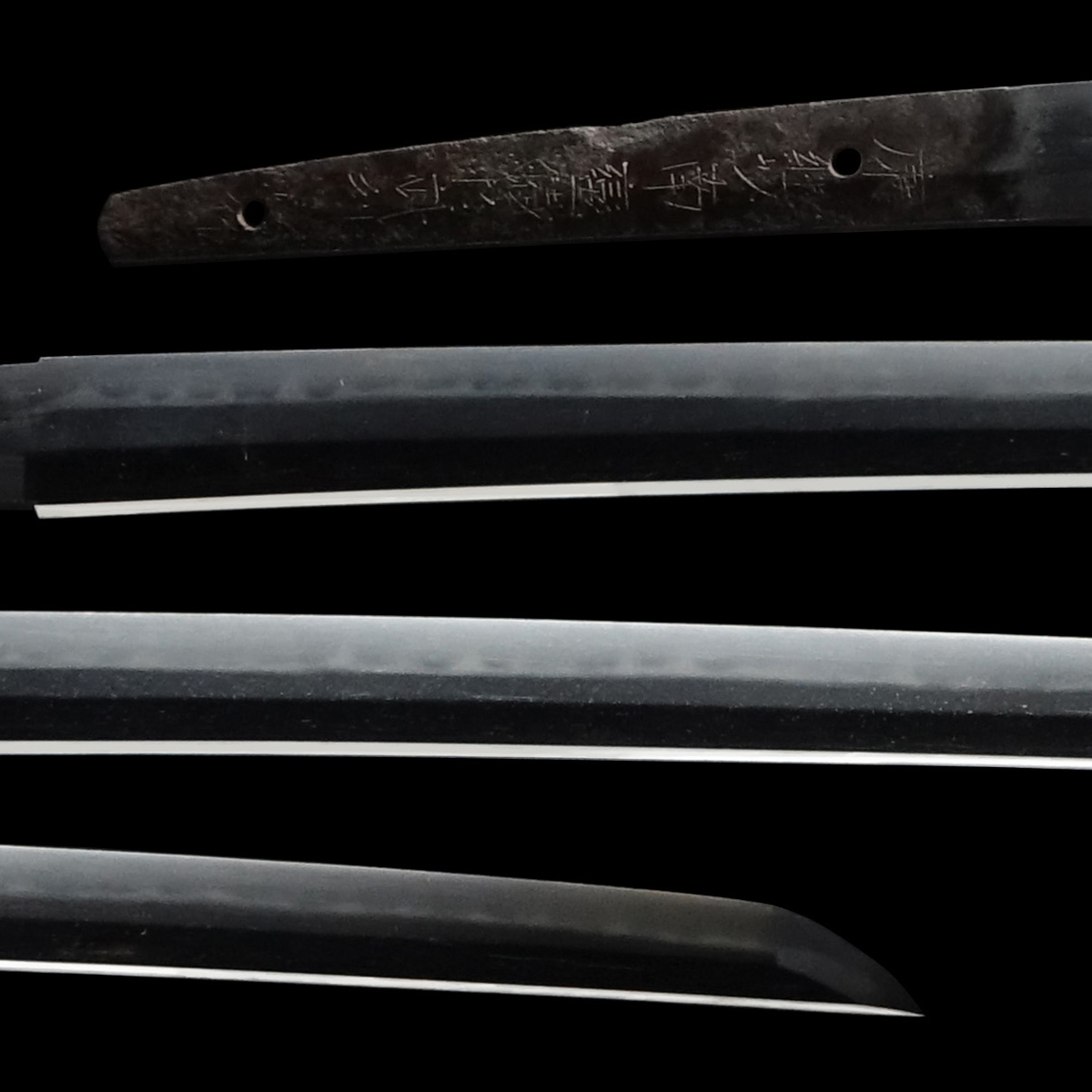
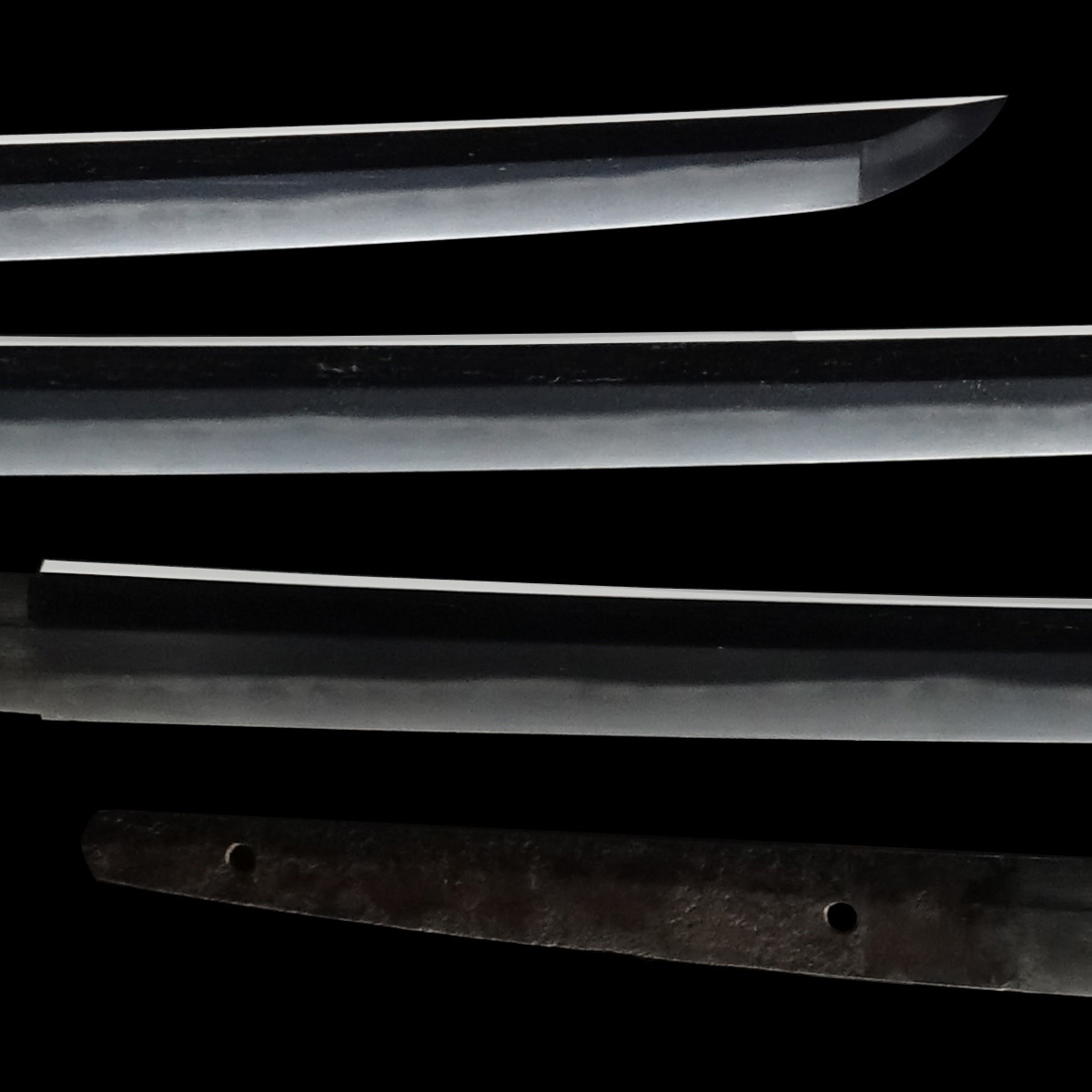
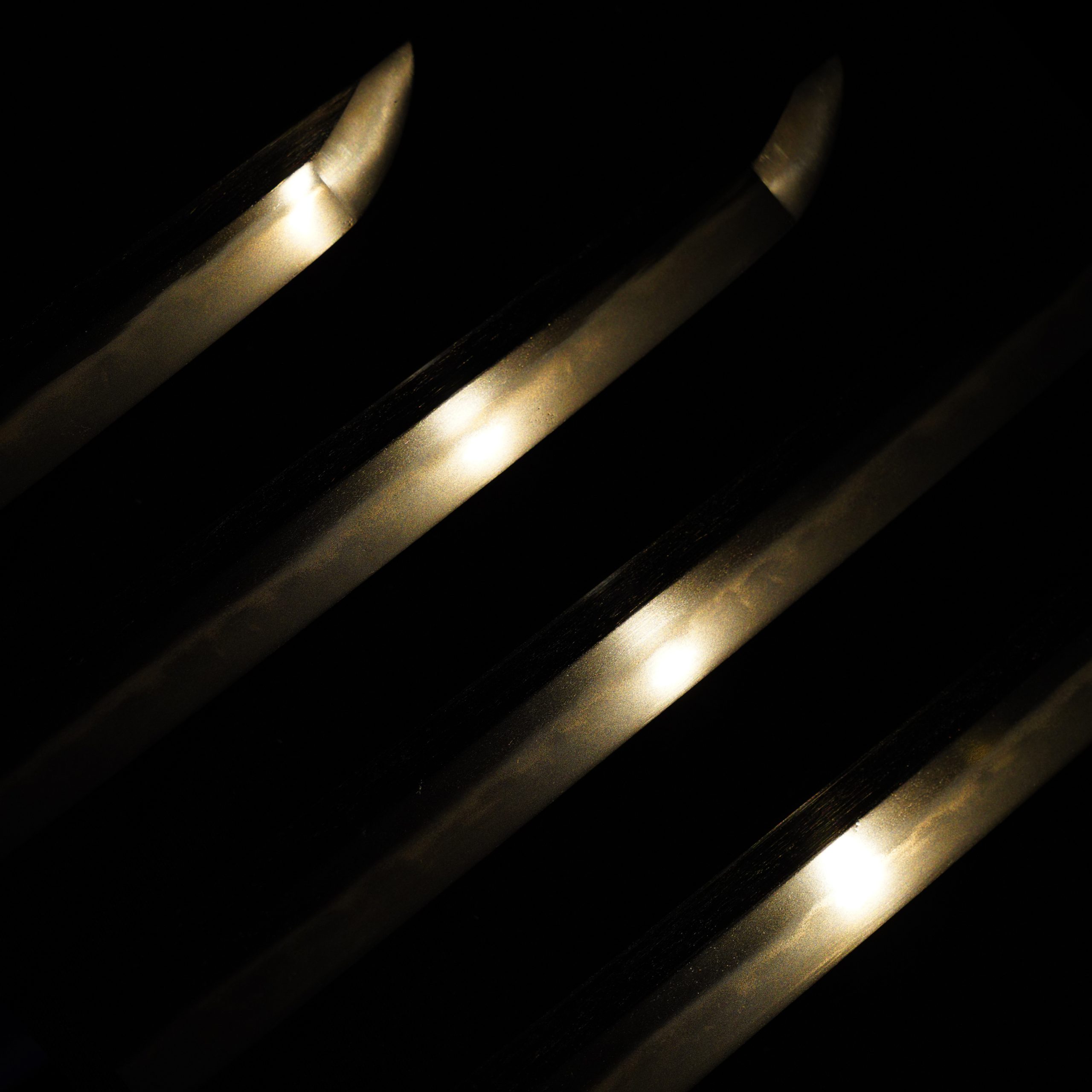
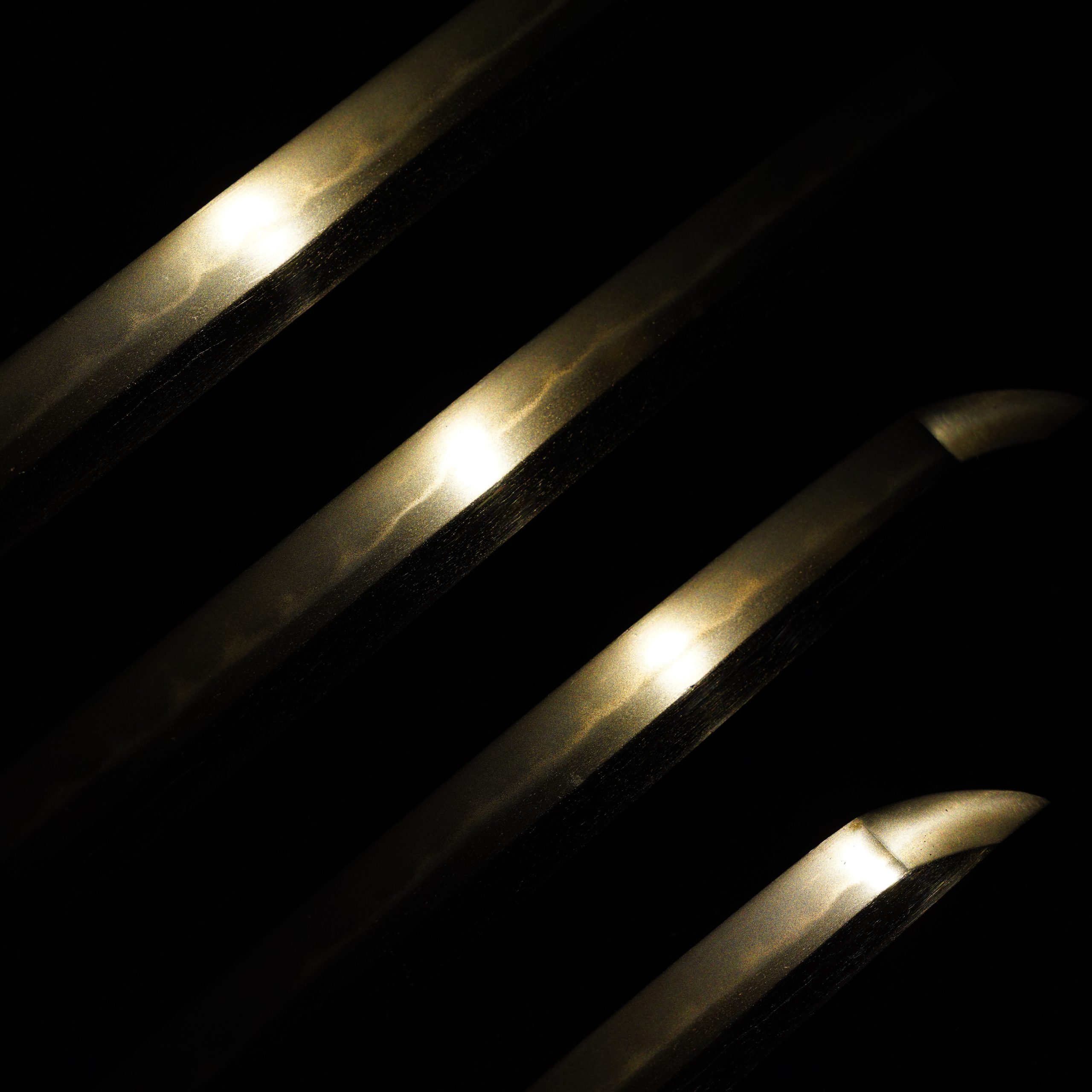
Nakago:Nakago is the tang of the Japanese sword.
Japanese swordsmiths left the black rust on the tang because it prevents red rust while the tang is in its handle. And the discoloration of the tang was created over time, and it is a great indicator for a Japanese sword specialist to estimate when the sword was forged.
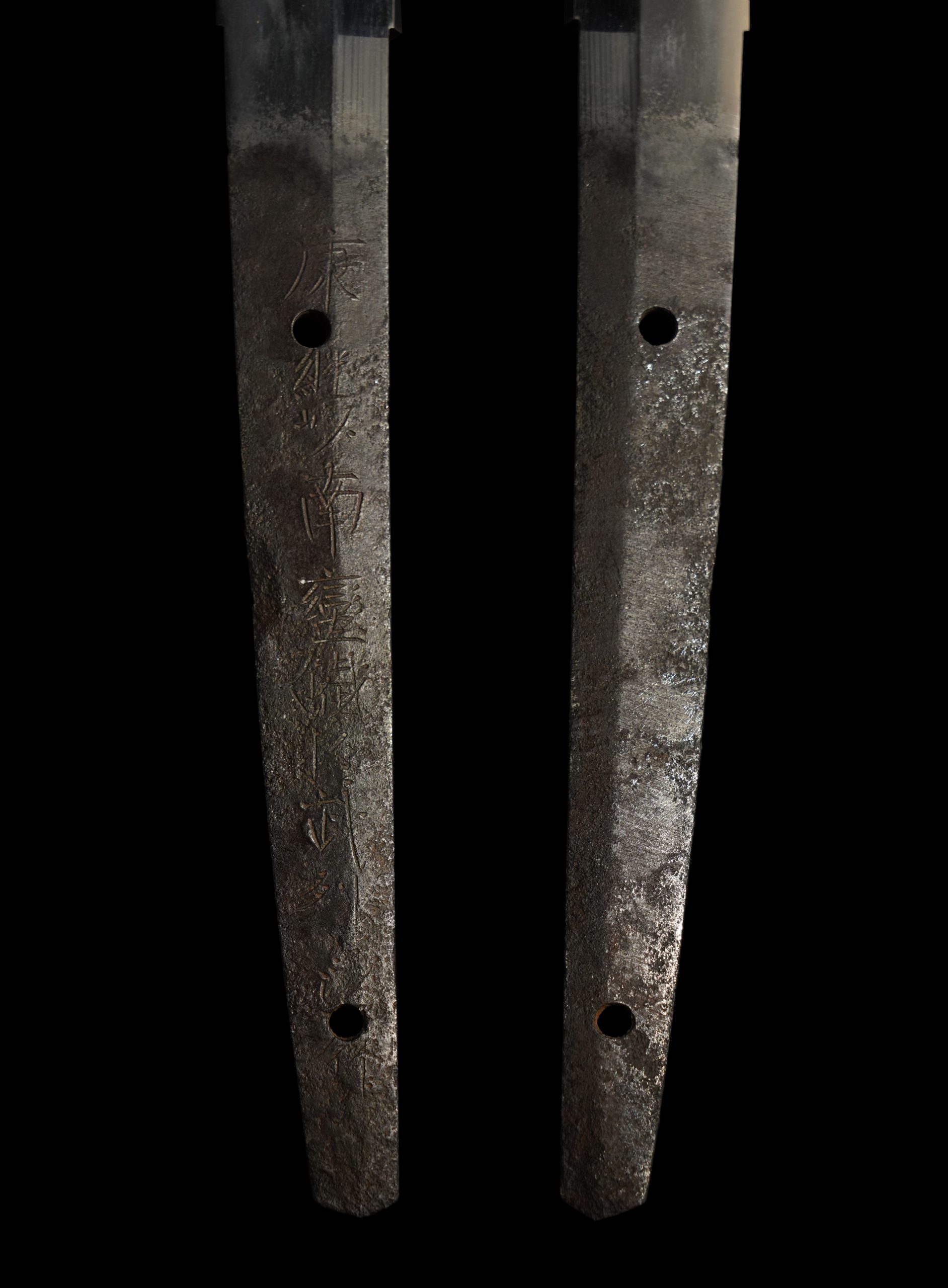
Koshirae: Koshirae is the mounting of the Japanese sword. There are several parts that consist of Koshirae such as Saya(Scabbard), Tsuka( Handle), Tsuba(Handguard).
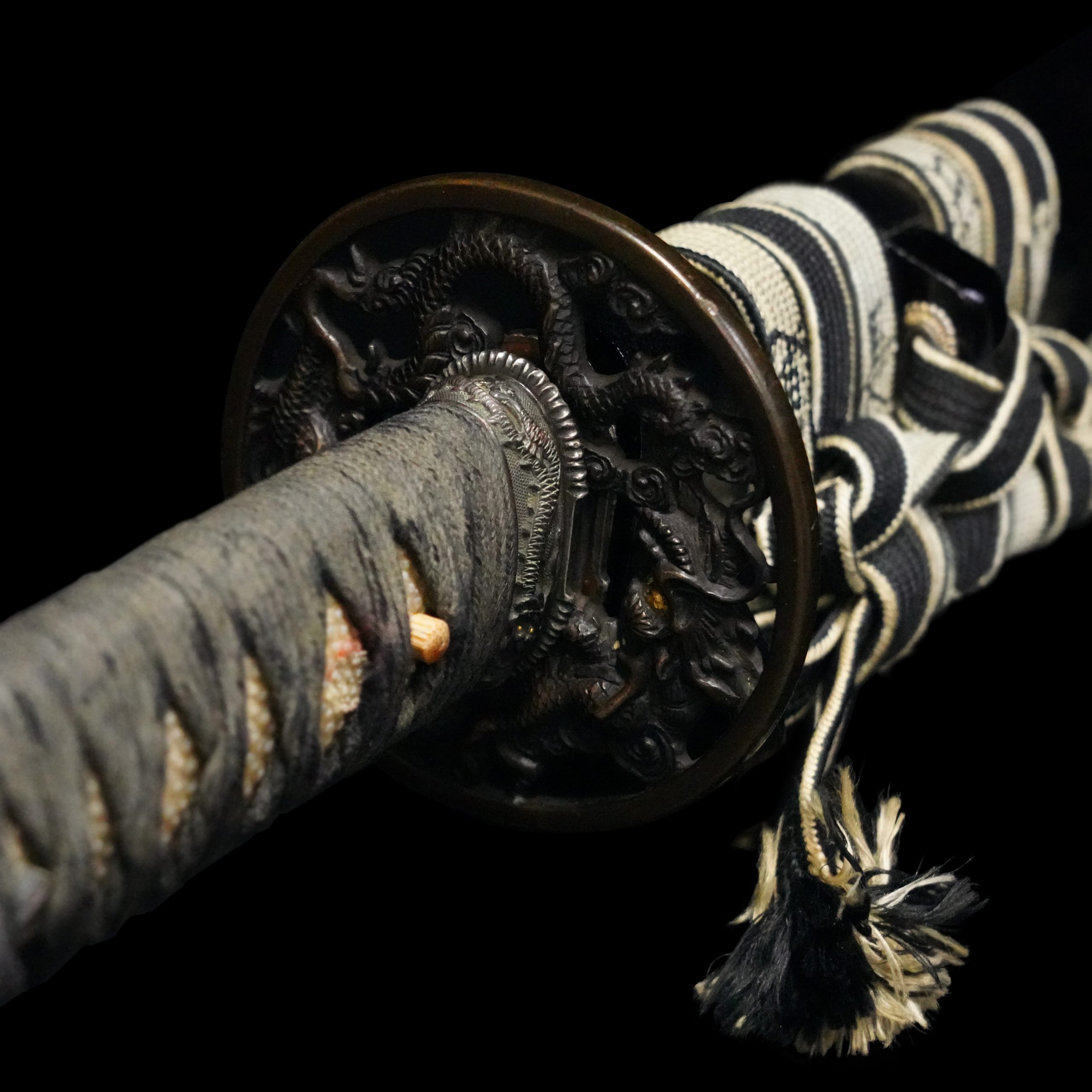
Fuchi-Kashira:A pair of matching sword fittings that cover the upper and bottom parts of its sword hilt.
The dragon is the motif of this Fuchi Kashira. They are engraved semi-three-dimensionally, and their eyes are colored with gold. The background of this Fuchi Kashira is decorated with small dots. This type of surface is called the Nanako-Ji (魚子地). By hitting with the Nanako-Ji Tagane (魚子地鏨, chisel used for this technique), delicate fish egg-shaped protrusions are made on the entire surface of the Tsuba. It shows us the maker’s expert skill.
Initially, the dragon is an imaginary creature found in ancient traditions or myths. Furthermore, this beast has been regarded as a symbol of auspicious signs. Its body is likened to nine animals: antlers are deer, the head is a camel, eyes are demons, the neck is a snake, belly is Mizuchi (蛟, mythical animal in Japan which looks like a snake and have a horn and four legs), scales are fish, claws are falcons, palms are tigers, and ears are cows. It was thought that the dragon would reign at the top of all animals because of its odd-looking appearance. Still today, the dragon pattern maintains its meaning as the all-purpose auspicious pattern.
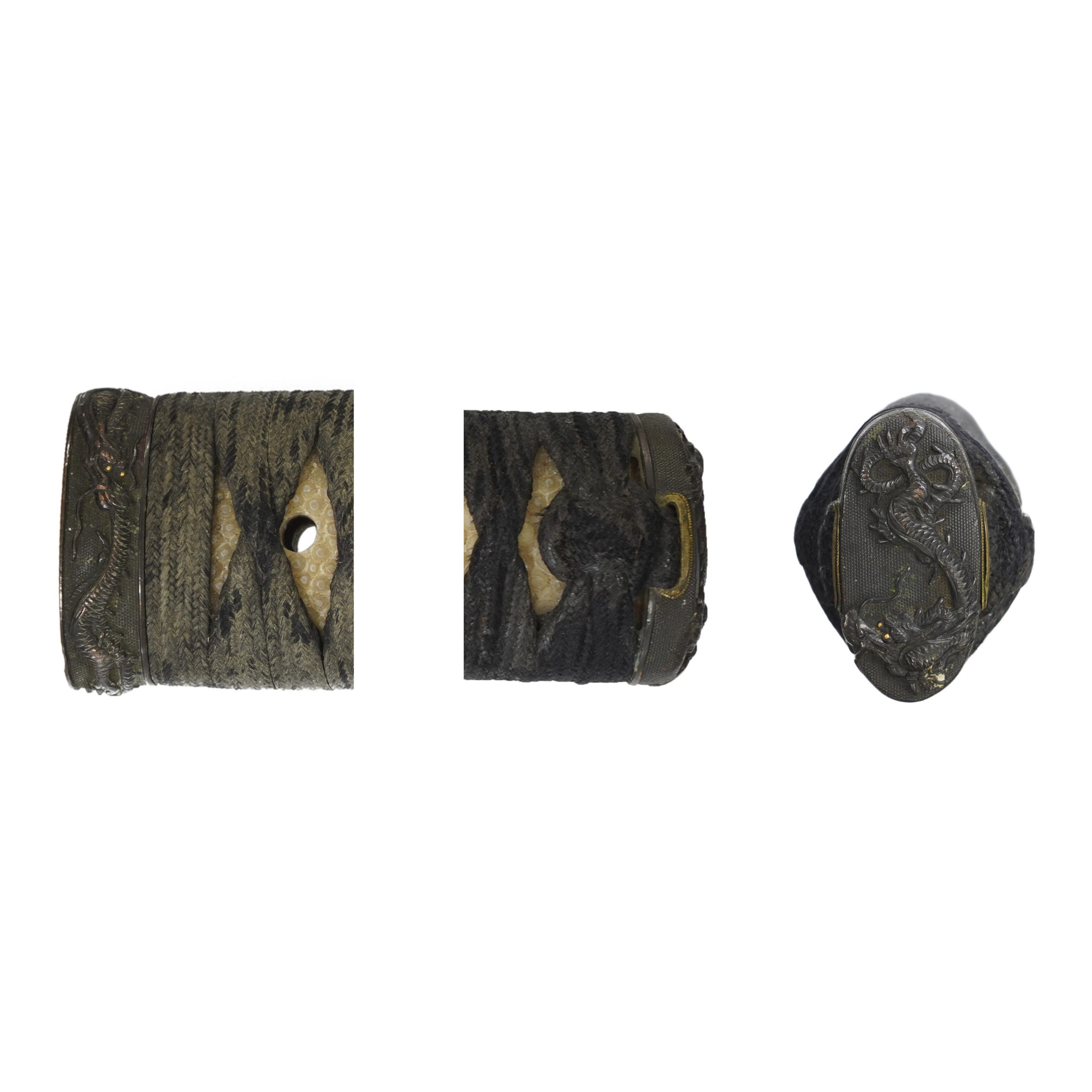
Tsuka and Menuki:Tsuka is the handle of the Japanese sword and Menuki is its decoration.
Due to wear caused by aging, it is challenging to judge the entire original design of this Menuki. Seeing the shape from the gaps of Tsukamaki Ito (thread coiled on the handle), it seems that Samurais’ figure in small boats is depicted. The golden parts might be their armors. Since the other sword mountings’ motif are dragons (a god beast regarded as a water god), this Menuki’s design might have been chosen, wishing them success in the battle on the water and the safe return.
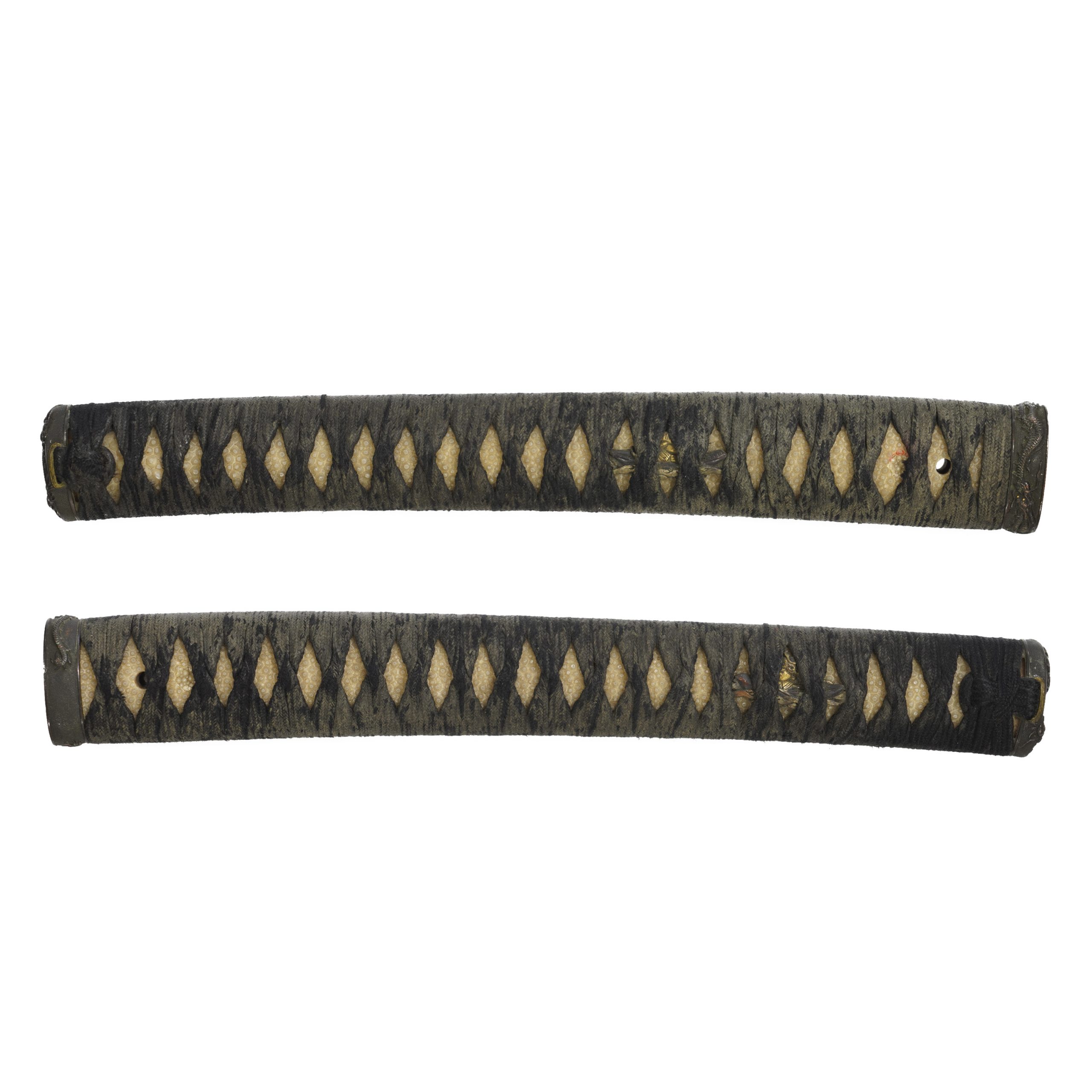
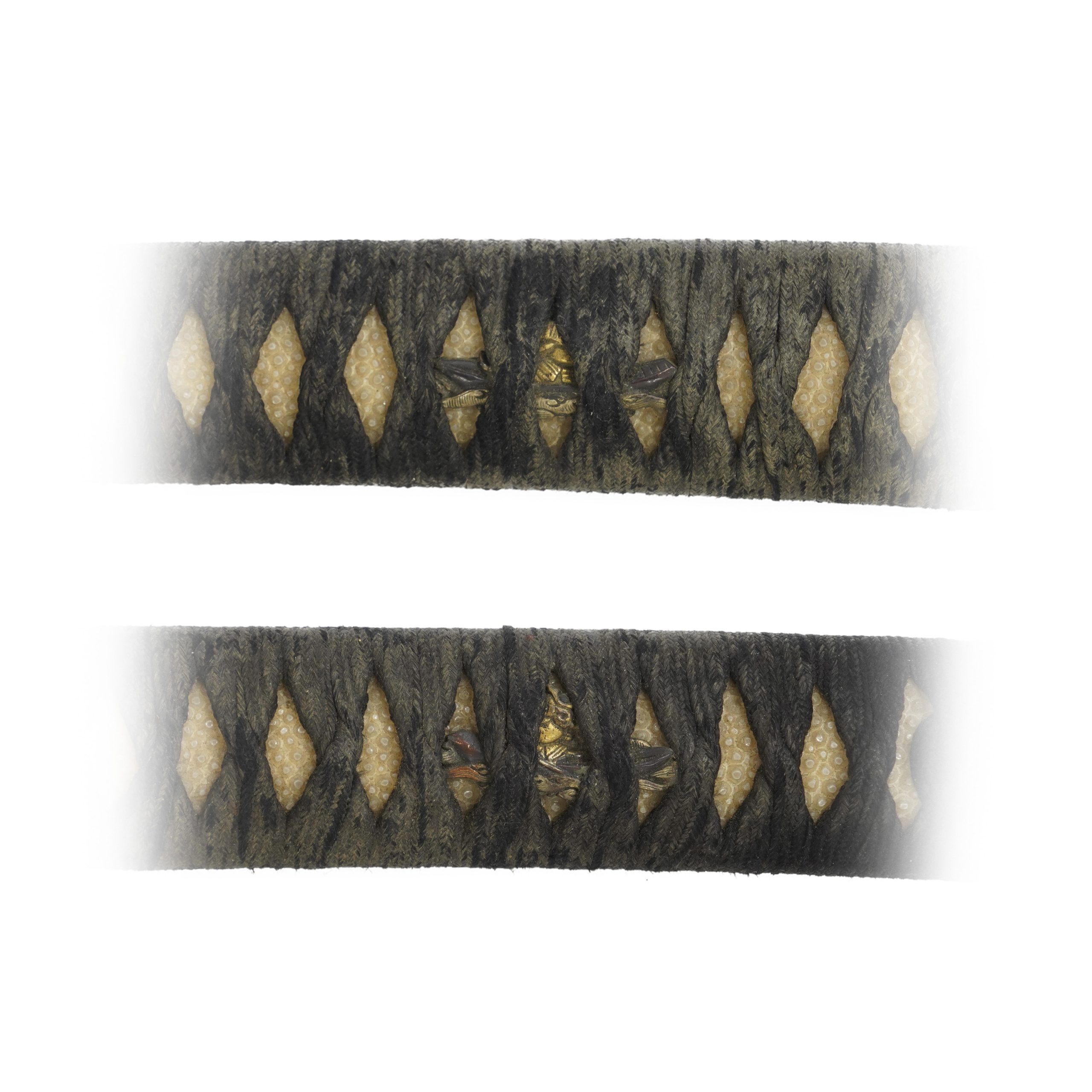
Tsuba and Habaki:Tsuba is the handguard for the Japanese Sword and Habaki is the equipment to make the blade not touch its scabbard inside. It prevents the blade from getting rusty and chipped.
Same as the Fuchi Kashira, this Tsuba is also decorated with the dragon motif. The dragon twists its slender snake-like body in a circle. And the clouds cling around the dragon. According to a theory, dragons and gods dwell in clouds.
In Japan, there is a belief that worships a dragon as a water god. This faith is called Ryujin Shinkou (竜神信仰). Since rice cultivation flourished in this country, water is always an essential resource. People believed that the dragon would control water, and clouds bring blessed rain. It might be the reason why the combination of dragon and cloud design is often seen.
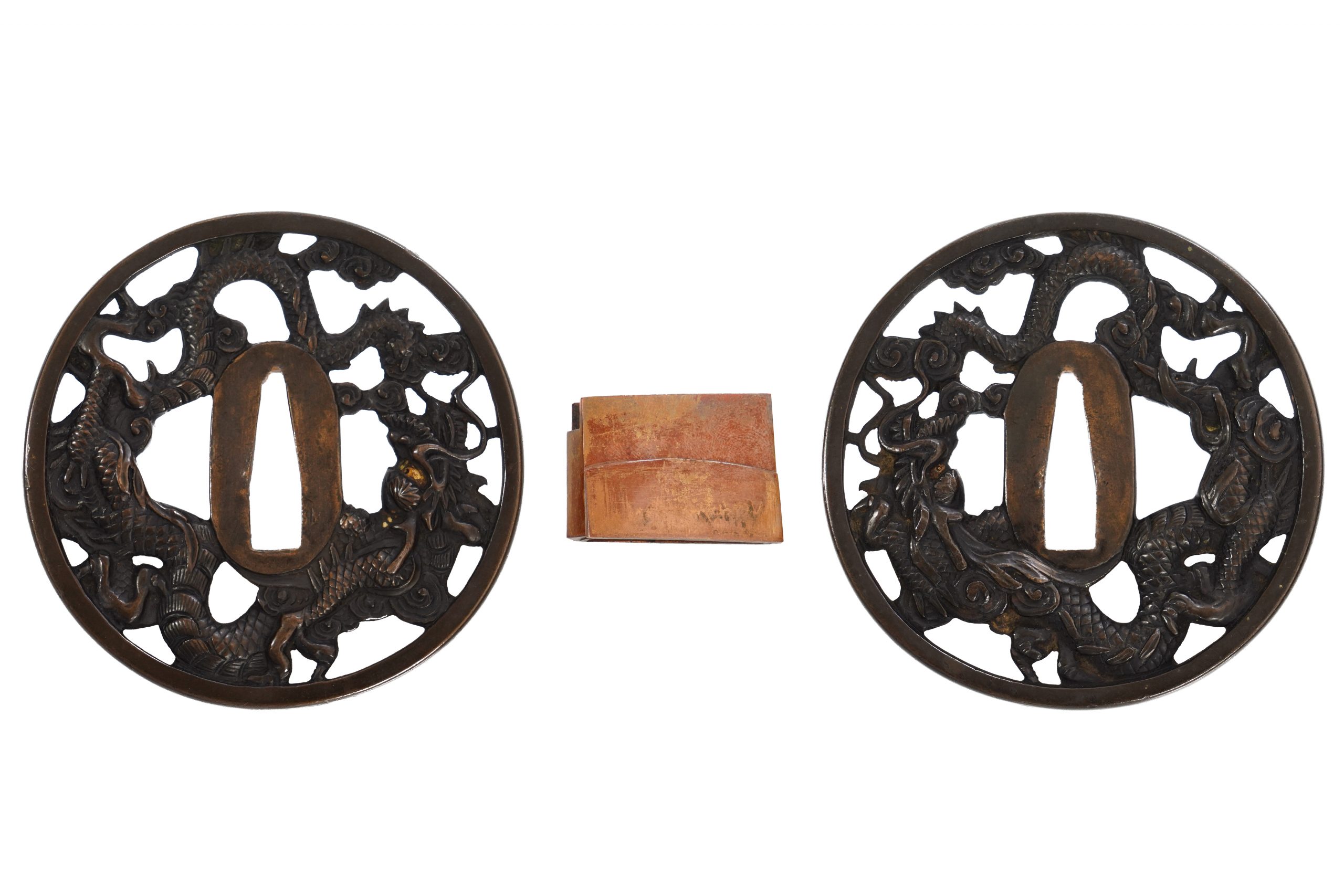
Saya: Saya is the scabbard for the Japanese sword.
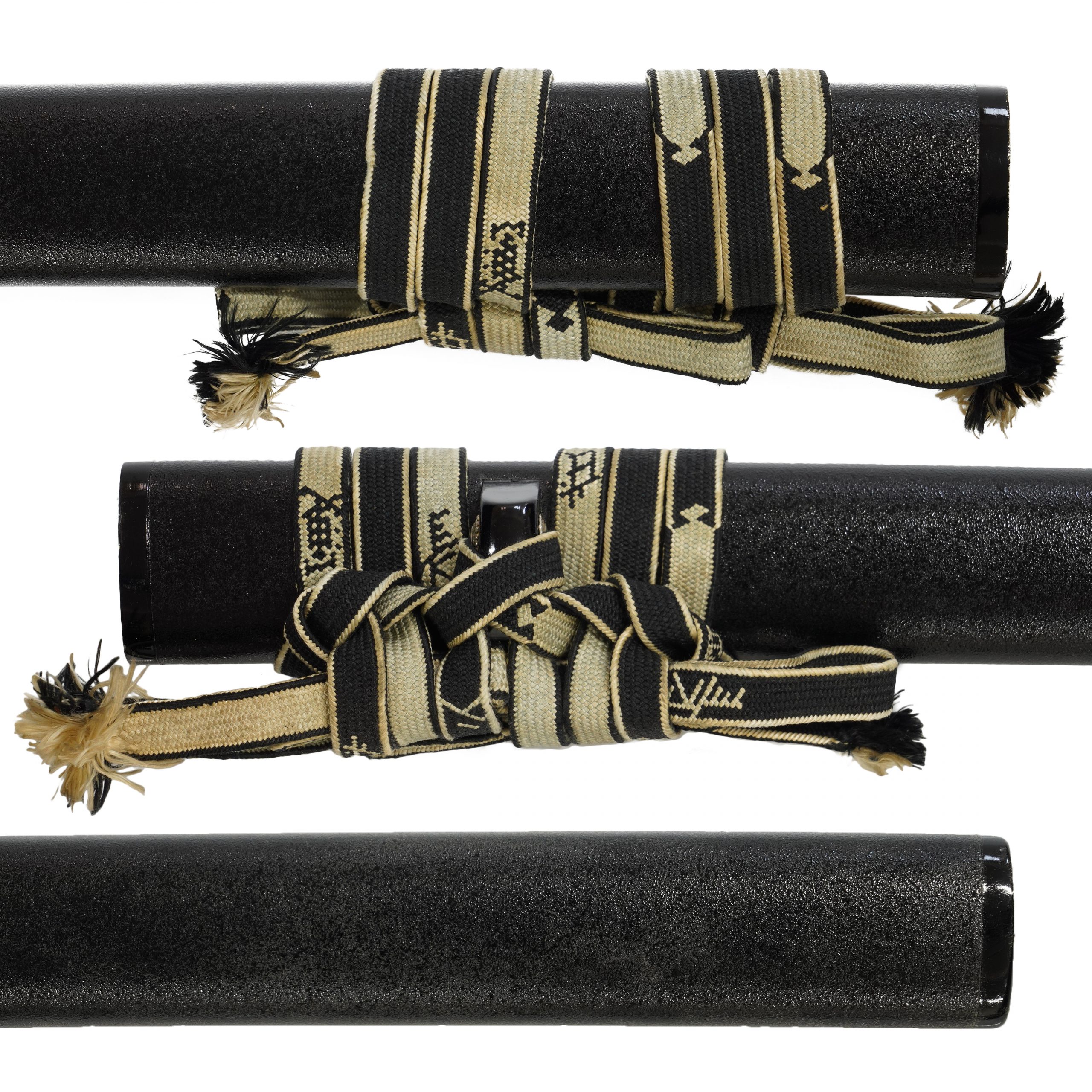
Authentication Paper:NBTHK TOKUBETSU Hozon Certificate for the blade
NBTHK, also known as Nihon Bijutsu Touken Hozon Kyokai (the Society for the Preservation of the Japan Art Sword), is one of the oldest Japanese sword appraising organizations in modern-day Japan. They authenticated the blade on Nov 9th in the second year of Reiwa (2020). They appraised it as Tokubetsu Hozon Touken, the blade especially worth preserving for Japanese society. The purchaser will receive this original certificate as well. We can also translate what is written into English and make a PDF file for your record if you request.
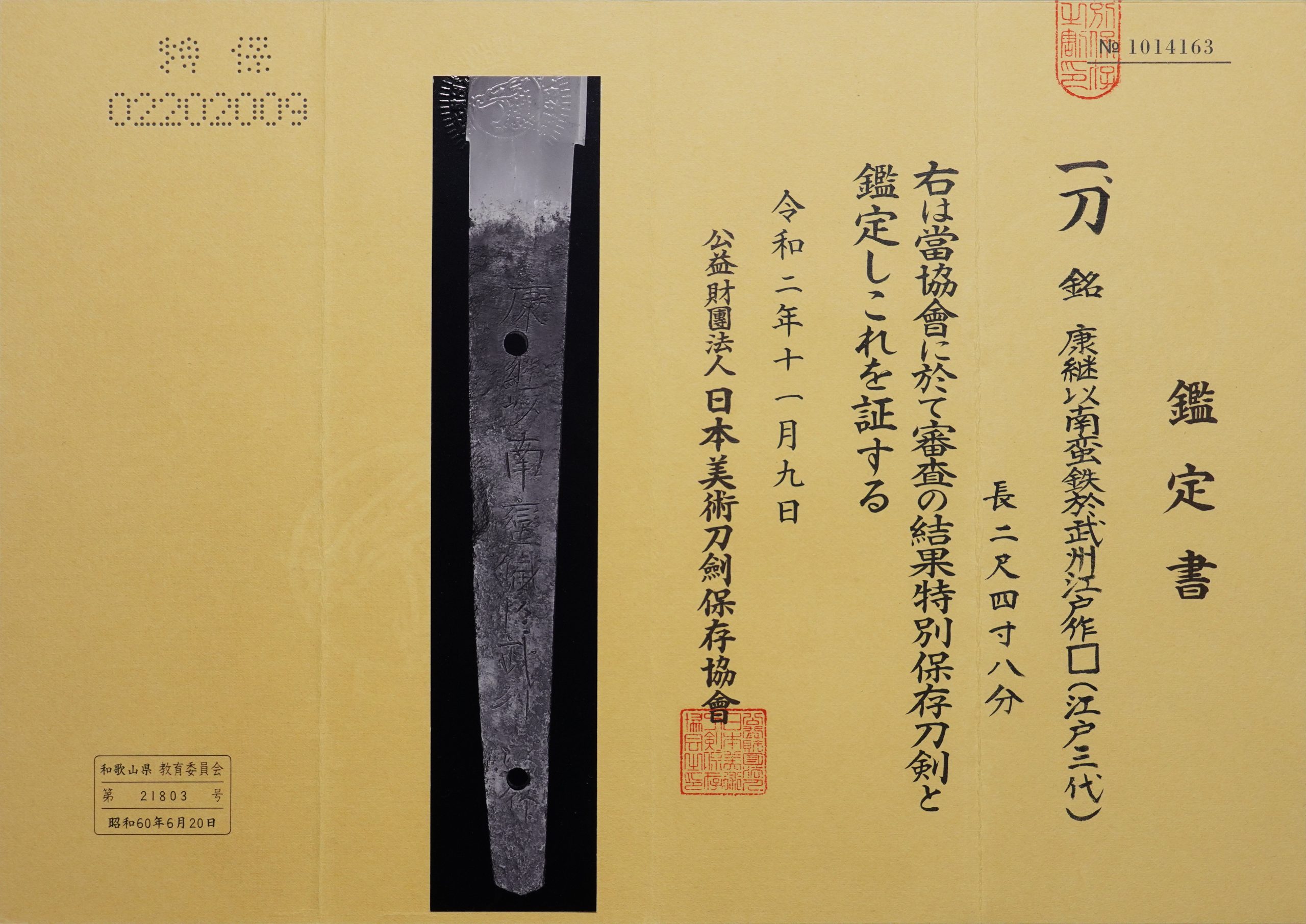
Registration Number : Wakayama 21803
The Board of Education in Wakayama prefecture issued a registration paper for this sword . It is called Jyu Token Rui Torokusho(銃刀剣類登録証). Bunkacho(The Agency for Cultural Affairs) acknowledges a Japanese sword with this paper as a work of art.
The sword needs to be traditionally hand-forged and made of Tamahagane carbon steel to be registered in the system. With this paper, its owner in Japan can legally own an authentic Japanese sword. Based on this registration number, we will apply for its export permit.
This paper will need to be returned to the board of education when the sword is being shipped abroad, but you can receive a copy of it. An English translation of this registration paper is available on request.
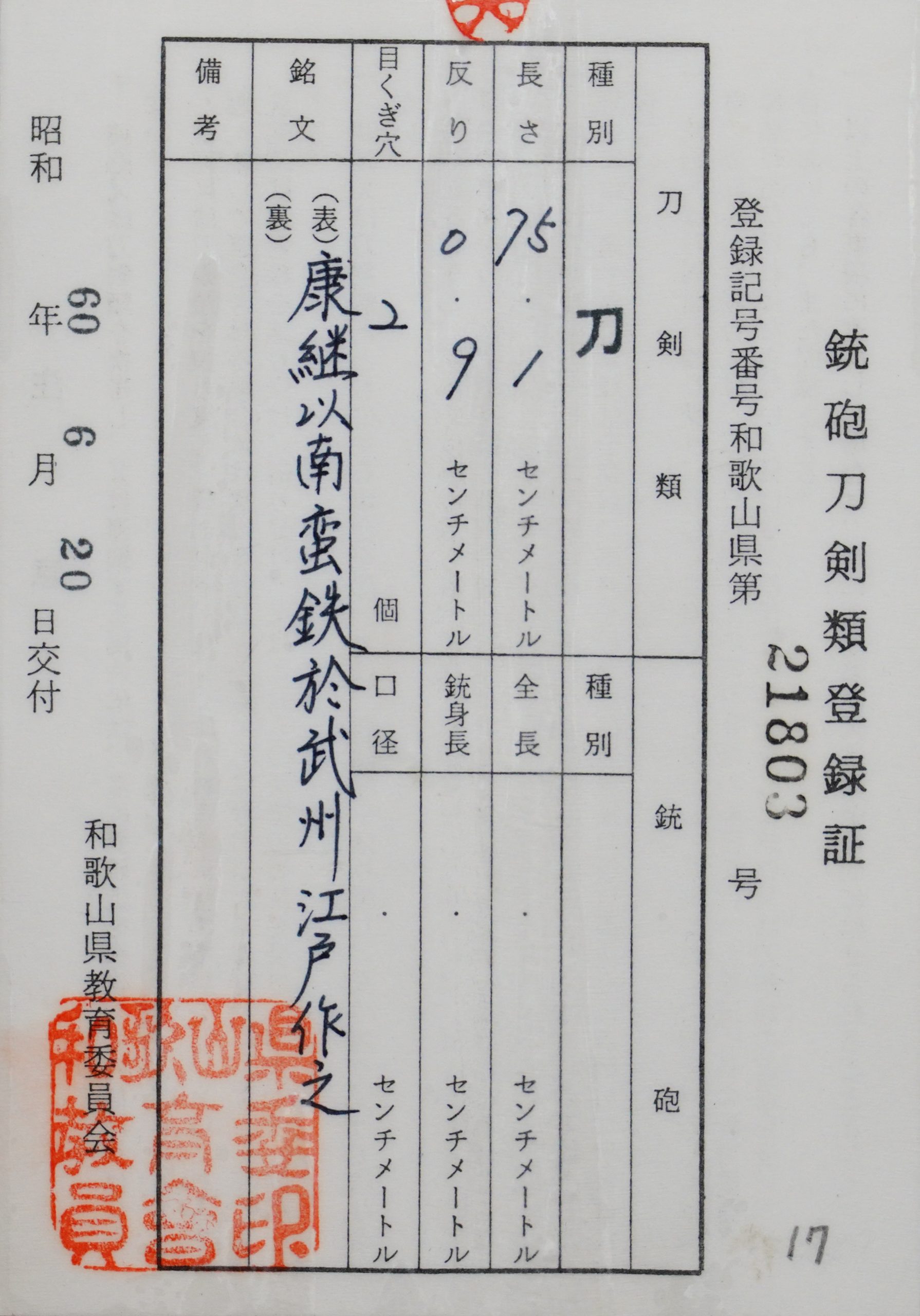
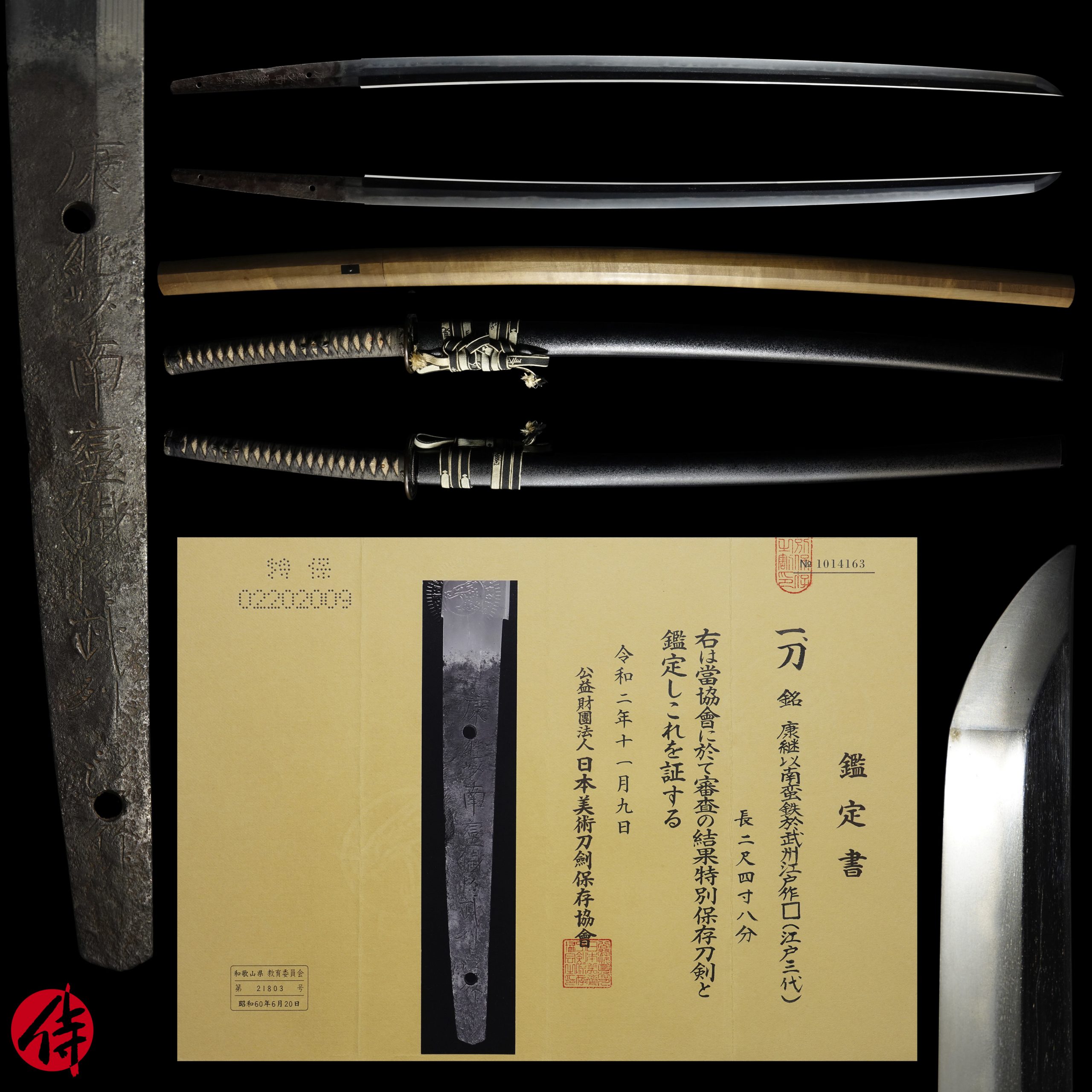
—————————————————————–
【About us】
Samurai Museum is located in Tokyo, Japan, exhibiting antique artifacts related to the Samurai history. Samurai Museum Shop is the place for those who are interested in Japanese culture and craftsmanship. We deal with antique Samurai swords/armor, traditional crafts made in Japan and so on.
【Japanese Sword& Export Process】
The Japanese swords we deal with are hand-forged edged swords made in Japan. It was made from the traditional carbon steel called TAMAHAGANE(玉鋼). Samurai Museum is familiar with the proper legal procedure for an antique/ authentic Japanese sword to be exported from Japan. We have sent more than 300 Japanese swords to amazing owners who appreciate its historical value.
Each Japanese sword is registered under the Agency for Cultural Affairs and the Board of Education in Japan. They issue a registration paper for each Japanese sword for its owner in Japan to legally possess it. The Japanese sword with its registration paper means it was traditionally hand-forged in Japan.
To legally export the sword from Japan to other countries, we will have to apply for its permit to the Agency for Cultural Affairs(Bunkacho) and return the original registration paper to the Board of Education. It normally takes around 2-4 weeks to receive this permit after submitting required documents. And we would like you to expect at least 1-1.5 months for your order to arrive at your given address after you ordered. For more detailed info, please click here.
It is allowed for residents in Japan to own authentic Japanese swords without a special license as long as they come with registration papers. Please feel free to contact us if you are a resident of Japan, whether temporarily or permanently. We will also assist you when you leave Japan and need to obtain the export permit.
【Payment Method】
We accept payment through Stripe (Credit card), PayPal, Apple Pay or ChromePay, all of which are secure payment methods. Also, you don’t need to make an account on Stripe for the checkout. If you prefer other payment method, please contact us. After confirming your payment, we will apply for an export permit. You may either pay in JPY, USD, AUD, EUR or GBP. The price is set in Japanese Yen. Prices in other currencies are automatically calculated based on the latest exchange rate.

【Shipping】
We have shipped authentic Japanese swords to the USA, Canada, Mexico, UK, Germany , France and Hong Kong. If you don’t live in these countries and like to order, please contact us first before making a purchase. We offer Free International Shipping as long as we can send antique Japanese swords by either EMS or FedEx(Canada).
We normally ship by EMS(Express Mail Service) provided by Japan Post. When we receive an order from the Canada we will use FedEx instead as EMS temporarily stops shipping from Japan to those countries due to COVID-19.
We will send you a tracking number for your order as soon as we hand it to the post office/FedEx. We will put 100 % insurance on the shipping document without any extra charge. Based on the total amount, there might be a duty tax or other fee for you to pay, depending on the countries. We use package cushioning to protect the item and put it in a PVC pipe, which is one of the most secure packages because of its durability.
It will normally takes 5-14 days for the item to arrive at your given address after we dispatch it. Time of delivery is estimated as accurately as possible by the carrier but does not take into account any delays beyond our control such as by inclement weather, post office holiday seasons.
*Please keep in mind that due to the spread of COVID-19, there might be delays in shipping. If you like to know the detail about shipping, please feel free to ask us.

【How to make sure the condition】
Please keep in mind that what you are going to purchase is an antique item. We uploaded high resolution photos for you to check its condition thoroughly. If you like to see more photos with different angles, please feel free to contact us. We will be happy to send them to you so that you can make informed decision. It is essential for us to know that you are happy with your choice of a sword. and we are prepared to use the best of our ability to serve you.
【How To Contact Us】
Please contact us through email, Facebook Messenger or Live Chat if you have any questions. You can find each icon on the right side of the website. Please click one of them to reach us. We will reply to you within 1-2 business days.
【The Art of Nihonto(Japanese Sword)】
Samurai’s history is a profound, eloquent legacy of ancient Japanese warriors in which millions of people worldwide are being fascinated. If you like to find out the art of Nihonto, please click here.
【A Guide to Japanese Sword Maintenance】
After acquiring an genuine Japanese sword, it is also important to know how to take good care of it. Here is the special video for you. Mr. Paul Martin, Japanese sword expert, shows you how to give proper maintenance to your sword. When you purchase a Japanese sword from us, you can get a Free sword maintenance kit, which appears in this video.

